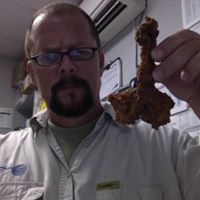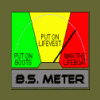Leaderboard
Popular Content
Showing content with the highest reputation on 10/03/2009 in all areas
-
Hi, I've been wondering, what is the proper/best way to perform CPR on a cardiac/full arrest patient while on a stretcher that is moving? Is it a wise idea to put both feet on the stretcher's bottom rails? Could you potentially distribute the weight unequally and cause the stretcher to fall? Also, one more thing. I understand that quality CPR is performed best when the person is directly over the person they are doing CPR on with their arms locked. In an ambulance situation, is it appropriate to sit on the bench and perform CPR or would it be necessary to stand so you could be directly over your arms when compressing? Thanks.2 points
-
Well since the rest of the "refugee's" are doing their intro's, I guess it would be proper etiquette to do the same......... Its been a while since I was here, i've been lurking every now and then, but have been focusing my minimal spare time on another site. While I felt like that site was my "niche" so to speak, I have recently lost interest as I feel it no longer provides a needed level of productivity or worthwhile purpose. Soooooooo... I return to the City! Hindsight being 20/20, I should have never left. It will be good to get back in touch with some old friends. So hello again!2 points
-
Thanks for the reply. I think that this is a turf war. Many people feel- and rightly so- that the fire service receives most of the attention and the funding when it comes to public safety. The problem is on both sides of the issue- fire service wants to make sure that they remain "in the loop", and despite the fact that we will ALWAYS need fire protection, thanks to advancements in construction, building codes, fire prevention, and education, fires are down. That means to maintain their level of funding they need to become more relevant, and absorbing EMS is the best way to do that. EMS feels that fire infringes on their turf and does not have the same level of commitment towards providing medical care- ie fire is only doing to because they have been forced into it. Yes, many of the opinions expressed about fire, EMS, and their relative capabilities are generalizations, but there is some truth to them. I've been in both worlds and in hospitals as well. Again, the problem is that a pressing issue for one area is NOT an issue at all somewhere else, thus to have a united front- on either side- is tough. The reality is that for some time, agencies are being asked to do more with less, and anyone who can wear multiple hats is an asset to their agency and their bottom line. In these economic times this couldn't be more accurate. Is this the best thing for the public- well, that still remains to be seen, I guess but what choice is there? I think we all must adapt to these changes in order to survive and that means compromise on all sides of the issue.2 points
-
2 points
-
2 points
-
I've seen posted here over and over about the reported side effects, and the fact that this vaccine is being pushed out to healthcare workers without being 'fully vetted.' Could someone please post sources for these claims? They come from some of our more respected posters, so I'm in no way calling bullshit, I just haven't seen them and found that none came up easily during a Google search. Thanks for your help. Dwayne Edit. That's weird, these were actually two separate posts that the program combined into one...anyone else have this happen? Other than making this note, nothing else was altered during the edit.2 points
-
Ditto. Props for taking the time to properly introduce yourself. Welcome aboard! Jump right on in.2 points
-
Yup that is a good change as one person that called me out on the forums started finding every post and hitting negative. In one hour I was at negative 13 or so. So I am happy admin made that change. Now it will take 13 days for me to get to negative 13 unless everyone hates me.2 points
-
It only lets you give one negative in any 24 hour period, so it shouldn't be easily abused.2 points
-
No sir. Thank you for the change as maybe it will help keep someone that is being a jerk from finding every post and hitting negative like happened to me recently.2 points
-
I get how to use the system... but how do you see details on your "rep" in your profile? I can't for the life of me figure it out. --Wendy2 points
-
Richard B. recently posted this topic. http://www.emtcity.com/index.php/topic/16362-h1n1-update-from-new-york-state/page__hl__H1N1__fromsearch__1 This subject is now a heated discussion on many other forums for many other health care professions. NY has made it mandatory and there is now big controversey in that state amongst the health care workers. Health Care Workers Protest Mandatory H1N1 Vaccination http://www.cbsnews.com/blogs/2009/09/29/taking_liberties/entry5349581.shtml September 29, 2009 11:28 AM Health care workers are planning to take to the streets Tuesday at a rally in front of the Albany, N.Y. state capitol to protest mandatory vaccination. The rally is intended to call for "freedom of choice in vaccination and health care" and to protest mandatory vaccination for influenza and the H1N1 swine flu. "This vaccine has not been clinically tested to the same degree as the regular flu vaccine," Tara Accavallo, a registered nurse on Long Island, told Newsday. "If something happens to me, if I get seriously injured from this vaccine, who's going to help me?" While physicians, nurses, and medical technicians may not be known for their willingness to march on state capitols, a recent New York Department of Health requirement has sparked an unusually intense response. The August 13 regulations say that all health care workers who "could potentially expose patients" must be vaccinated for influenza by November 30 unless it would be "detrimental" to the recipient's health. (Any reprieve would be temporary and last only until injection with the vaccine would "no longer be detrimental.") This raises an obvious and important question: Under what circumstances can government officials order mandatory vaccination? And could the general public be ordered to roll up their sleeves for injections, even if there might be side effects beyond a sore arm or mild fever? The concern in New York also comes as skepticism of vaccination in general seems to be on the rise. First, some stipulations. Let us stipulate that that routine vaccination has virtually wiped out, at least in developed countries, once-rampant diseases like mumps and whooping cough. The horrors of smallpox -- variola major, which slays about a third of its victims, and the less deadly variola minor -- have vanished, thanks to a successful worldwide vaccination campaign. Even where mandatory vaccination can cause complications, the overall side effects in a population of millions will almost certainly not be as harmful as the infectious disease itself. On the other hand, let us stipulate that not all vaccines are created equal; some may be safer than others. Out of lack of knowledge or fear, officials may order mandatory vaccinations when the vaccine has not been proven completely safe. And we should remember that the history of our own government when it comes to vaccines is not without its low points (more on this below). Perhaps the best overview of the legality of mandatory vaccination lies in a 2005 report prepared for the U.S. Congress by the Congressional Research Service. It notes that while the federal government does have the power to order quarantines, public health has historically been the states' responsibility. The CRS report adds: "Generally, federal regulations authorizing the apprehension, detention, examination, or conditional release of individuals are applicable only to individuals coming into a State or possession from a foreign country... Any federal mandatory vaccination program applicable to the general public would likely incorporate similar jurisdictional limitations." Much more to read at: http://www.cbsnews.com/blogs/2009/09/29/taking_liberties/entry5349581.shtml1 point
-
I haven't been to the city for a while, as paramedic prerequisites, work and life kind of got in the way. I've just started Paramedic School and I wanted to get re-involved with the forum, because I know I'll have questions and thoughts that I'll want to run by you folks. For a while I was frequenting a different forum, but as people were leaving, either by their own choice or a swing of the ban-hammer, I realized that all the people I really wanted to hear from, the smart people, people who could back up their opinion with cited facts, people like VentMedic, RidRyder and Dust were hanging out over here. So, I'm back.1 point
-
Hello, everyone, I'm new to this site. It looks way more promising than other sites I've been to. A little about myself - 33 y/o, married, one daughter (5) and one on the way (girl), currently employed as a firemedic in Northern Va. I got my start in EMS at Hunter Ambulance-Ambulette inc. an IFT company in Inwood Queens per diem, for around 6 months. Next, I was a EMT-B for three years FT at the NSLIJ CEMS, a combo nyc 911/IFT agency, hospital based. After that, I worked for two years as a medic for the CEMS concurrently with a stint as a medic at the Flushing/Jamaica/Brookdale hosp system. I secured my NREMT-P and then relocated to Charleston SC and worked as a medic for their county run third service 911. Finally, I was hired as a firemedic at Fairfax County FRD, and have been here for the past year and a half. My career development goals include moving up in rank at the FRD as an All-Hazards officer, maybe up to Capt II. I would also like to get into EMS education here, as I would like to ensure that educational standards and proficiency are continually improved at the FRD. I'm also debating going for either RT or RN. The FRD is very pro education, weighs it heavily for promotions, and will allow me to use leave to attend class on work days if needed. If I go RN, I may seek to do flight on the side, either as a medic or RN, whichever results in a job offer. I hope to contribute positively to the site, as well as improve my proficiency as a medic. I believe strongly in fire based EMS (only if run well, for the right reasons), and having secure employment with a defined benefit (pension), good working conditions, unionization, and a livable wage. The main motivating factor for going to the fire side was for those reasons. I've found, luckily, that I enjoy fire almost as much as EMS, maybe 60% for EMS, and 40% for fire. I have respect, in general, for the employees of all versions of single role EMS agencies, to include volunteer. The problem arises when the fire bashing starts, and also when individuals preach how EMS in general doesn't deserve a livable wage or any decent benefits. I think that, even though educational standards may be low at the moment, that doesn't excuse employers from paying us welfare wages. Hence my pro union, or at least pro political organization stance, to protect the little guy (and gal), and give them a fair shake when dealing with management. Any problems I have with private or third service EMS are generally not with the employees, but rather how they're run, and how poorly the employees may be treated. I know that this post has been long winded, but I just want everyone to know where I'm coming from when posting. Thanks for viewing.1 point
-
So I was looking up the symptoms of the H1N1 and I'm confused. It seems there are such a varying range of symptoms that it would be hard to truly pinpoint. I read somewhere that cough, sore throat, fever were symptoms but to me that sounds more like an upper respiratory/strep throat than flu? Can anyone clear up what the actual symptoms are? Does a fever have to be present for it to be H1N1? Thanks!1 point
-
How about you start a thread on the subject? I can offer good discussion on the matter, as can others that are on the other side of the fence. The main problem that I see in the forums are individuals taking a particular FD's shortcomings and extending it to the entire fire service, like it's supposed to be the same everywhere. There are stellar examples of both fire based and third service EMS, as well as debacles of both. We can provide numerous case studies across the country to support either side of the argument, depending on what articles you cherry pick and what spin you put on it. No matter where you work, it's up to the individual to strive for excellence. I've seen plenty of skells throughout my travels on both sides.1 point
-
Several people keep bringing up the fact that the H1N1 vaccine has not been fully studied. With any medication, the final phase of the study is on a large human population. There is no way to really study a medicine until it is released on the population. This is why things like the cardiovacular effects of the COX-2 inhibitors (Vioxx, etc) were not know until after they were released. In phase 3 of the studies you are only testing the drug on several hundred to several thousand people. Sometimes, because your sample size is limited, problems such as the cardiovascular effects cannot be seen. Also keep in mind that everything we do in medicine carries some risk, giving aspirin and tylenol, intubation and even recieving your regular vaccines (Guillane-Barre anyone?).1 point
-
So... My name is Jon. I've not been that active here, but I just got an "EMTCity misses you" email... so I figured I'd come back and post a little and try it out again. I'm a new medic in PA, looking for job(s) and going though the process of obtaining Medical Command at a part-time job right now. It's a fun ride so far. Jon1 point
-
Hey Jon! I'm glad the site sends those reminders out, because I know how easy it is to forget about a website in the shuffle of life. This place is the very best resource for professional development I've ever found in thirty-six years of EMS though, so if you stick around and get involved, you may well be hooked. Thanks for coming back by!1 point
-
If you are still transporting primary arrests you need to be talking to your medical director about getting a field termination protocol.1 point
-
I see. I'm sorry if I misinterpreted your post. It had been an exceptionally shitty shift and I guess I just missed it. I tend to forget about BLS crews as we are all ALS here and our Medical Director trusts us for the most part. We ( my partner and I ) will work a code on scene to the max. but no ROSC, no transport.1 point
-
Greetings from the wild, wild west. I finished a 24 hour shift a couple of days ago. This is an easy day in the life of an AMR medic because it was not a 48. As you will read, sometimes it’s not about the length of the shift. The shift began badly. I confronted an acting supervisor about an incident on the previous shift. I tore him a new one. The good thing is 20 minutes later, he followed me out to where I was doing my rig check to explain himself. I took it as a win for two reasons. First, he cared enough about my opinion of him to actually try to make it right, and secondly, I had made my point. The first call of the day was a minor MVA. My patient was the restrained passenger of a car that had been rear-ended. He was complaining of neck pain – C1-C2. Routine. Stable patient, full immobilization and to the hospital. Second was a “non-emergent” transfer from regional hospital to big city hospital. The transfer was ICU to ICU. I get to bedside and my patient has no eye-opening, responds to voice with moans, is on a 20 mcg/min NTG drip, contracture of the left upper extremity, spasms of left upper and lower extremities. BP is 146/90, HR of 101, respirations of 27 per minute. History of multiple sclerosis and hip fracture. Patient has three peripheral IVs including an EJ. This is a “stable” patient going by ground? The nurse explains that the diagnosis is baclofen withdrawal secondary to possible pump malfunction and the patient is going to neurological ICU. She had started the patient on 40 mcg/min NTG to control BP and HR. Patient had gone down too much, rate had been adjusted to 20 mcg/min and symptoms were being controlled with Ativan. The last time I had questioned the stability of a patient for non-emergent transfer, I had been told by the Dr. that if he didn’t think the patient was stable enough, he would have called for air. My supervisor had told me to shut up, document my concerns, and transport the patient. I told the RN that I did not carry Ativan, and the only benzo options I have are Valium and Versed. She said that would work. I don’t have an infusion pump and told her I would have to take hers. She was upset about that. I told her that I would not take the patient without the pump (thank you St. V’s clinicals for making sure I am comfortable with the operation of the Alaris). She goes to confer with the higher ups and comes back with some ad-hoc paperwork pulled out of someone’s butt and it’s all good. I still have a hinky feeling about the whole thing, but it isn’t till well after the transport when I do some research that I find that if the Dx was on the money, the patient would be HYPO- not HYPER- tensive. Be that as it may, I load the patient and we head 100 miles across the desert. To make a long story short, the details of which include delays across the dam, bleeding air out of the pump lines several times (it’s bumpy and at one point, the NTG bottle flew off the stand), emptying my drug box of benzos, considering upping the nitro, being misdirected by staff at the destination hospital not once but 3 times, assisting the RN at the destination hospital switch out incompatible tubing and no food for 6 hours, we finally arrive back at the station (after returning the pump to 2nd floor ICU and replenishing my drug box) at 8:00pm to find the crews had had their butts kicked, running about 20 calls in the time we were away and that we were up for the call. This is two crews mind you, with a couple of the calls being handled by a move-up crew from the sub-station. Usually, when a transfer crew comes back, they drop to the bottom of the rotation. My EMT partner objects to us being up, but I silence her, telling her that rough as our transfer was, we had still had an easier time of it then the crews in the city. I get to sleep about 10:30pm to get toned out at midnight for a difficulty breathing out of town, part of our coverage area, about 20 minutes out running code. Female patient, 73 years, history of CHF, COPD, oxygen dependent. Patient has cellulites bilateral lower extremities extending to the knees. I feel the heat radiate off her legs, treated 2 ½ weeks ago for an unspecified infection. Pneumonia or pulmonary edema? Quiet in both lowers, sounds like snot in the right upper. I’m thinking diminished because of the COPD and snot because of pneumonia? Fire first responders had started A & A via SVN – I hate that. It’s routine around here – they think any difficulty breathing needs A and A. Until we get her in the ambulance, it’s their patient. We load up the patient and as we are lifting her (she’s a hefty one – blue bloater) and there is a gurney “incident”. My partner is about 5 feet tall, weights 100 lbs soaking wet and she was the leading contender in the station “who goes out with a career ending injury” pool. She had been back at work for about 4 months after 6 months light duty from her last back injury. All I know at the time is that we are lifting and suddenly the gurney drops. I am at the dumb end (cause I’m a moose) and she is operating the legs. I control the descent of the gurney; patient barely realizes there was a problem. The patient was sitting straight up and blocking my view of my partner. I don’t know what happened. I peer around the patient, make eye contact with my partner, she nods and we lift again. This time she goes up without incident. Gurney is not as high as I like it but my partner does not want to try again. I lift the dumb end into the rig, go around to lift the other end (cause I’m a moose) and the fire medic is already lifting. Totally against company policy, but I raise the legs and off we go. We are busy in the rig. I am treating pneumonia, the fire medic is treating CHF. She got about 250 mL, I checked lung sounds, shut off the fluids and we continued the CHF route. Fire medic was right, I was wrong. (This is only my 4th or 5th CHF patient in a year. It’s not the problem here in AZ like it is in WI. I guess that’s why we don’t have CPAP on the rigs.) PS.. sure makes that A & A treatment look good huh? We get to the hospital and my supervisor opens the ambulance doors. WTF? Fire medic has disappeared. Supervisor and I transfer care, I take care of the paperwork and return to the rig. It’s at this point that I become aware that my partner was taken to ED room 7 in a wheelchair. She had called the supervisor while driving and told him she was hurt. I am trying to make this really long story short. Bottom line – she is in CT scan, pumped full of dilaudid and muscle relaxers and telling the supervisor I dropped the gurney. I wind up waiting at the hospital until 3:30 in the morning while he does paperwork because we can’t get an EMT to man the rig and he is now my partner. When he is ready, we return to the station. I write out incident reports and try and figure out what happened. Opinion at the station is about 80% that the girl is looking for the injury and throwing me under a bus. I’m not so sure. I am filling out the paperwork to request evaluation and remediation if required of my lifting technique. I am more upset about this incident than anything else that has happened – or will happen – this shift. (yes there is more – I am so grateful to those of you still with me on this.) I don’t make it to sleep when we get toned out to a MVA on the highway. It is about 5:00 am. No idea what type of MVA or injuries if any. I ask my supervisor, who’s driving and is the senior medic if he wants patient care. He says no. I do the standard calculations of enroute times vs. launch times on a rotor and decide against a rotor. (20 minutes there – 20 minutes back vs. 35 minute ETA plus 15 to ED for rotor unless they are lying, which has happened.) On scene, I see the rear axle of a vehicle in the northbound lane. The rest of the SUV in on its roof about 100 yards south in the ditch. First responders are log rolling a patient. The fire medic is palpating the back. The fire medic is relatively new, excellent with medical, tends to freeze up on trauma. He’s the guy that was puking his guts out on the scene a few months back when we ran on the guy tortured with the box cutter. No O2 on the patient. EMTs directed to put a hi-flow NRB on the teenage female. She is messed up. In and out of consciousness, 4% partial thickness burn on right thigh, major lacs, abrasions, etc. etc. Scene time 9 minutes then running code to the hospital. Initial BP 128/70, HR 80. 8 minutes later BP is 103/58 and HR is 113. I got a BP cuff compressing the bag running NS into the I/O and a second line in the right AC. Bottom line – 2 16 year old members of the swim team going to practice. Both moms in the car following. SUV hits left guard rail, over-corrects and rolls. Both occupants ejected. Driver lying partially under the SUV, dead on the scene. My patient has basilar skull fracture and other injuries, flown out to trauma. I get back to the station at 7:30am. (no sleep except for 2 ½ hours and up since midnight.) Last but not least – I was supposed to be off at 8:00 am. One of my co-workers is doing FTO testing this am and was informed it would be from 8:00 am till 10:00 am and had asked me to hold over for him. He is a great guy and I am a big fan of improved education in the field. If you remember how I was thrown to the wolves when I started this job you will understand why. I surrender my rig to the on-coming medic and take over the rig my friend was in. In the minds of some of the pea brains that work here, this puts me up for the next call. I refused. It didn’t do me any good tho… the FTO testing started at 9:00 am and my friend was not done until 1:00pm. I ran calls. Thank you so much for reading this. It is an important part of my debriefing and I appreciate any comments you may have on any of this. Call me crazy, but I still love my job.1 point
-
1 point
-
Admin, my comp has been touchy today and I accidentally gave a negative point to someone I didn't mean to as I was scrolling across to push the positive my comp accepted the negative and I went OH CRAP ! To that person you had a good post I'm sorry !1 point
-
1 point
-
1 point
-
I dislike being befuddled, so help me out, here. What, or where, is NEPA, that you are from there? Anyway, welcome to the madness!1 point
-
Not to mention I accidently gave someone a demerit on that, as I had no idea what it was.1 point
-
If I was rising my hand in showing I was a member I would have raised it I was only "winking" at the members of the board who are members...they know who they are. I was merely agreeing with hardcoreemt on that I could name a person who fit the descriptions he posted. I did not imply I was one of them, just that I knew someone who fit. Psychic 101 is not necessary, just Reading 101. Did you answer his questions? I bet you could name someone who fit the description. Does that make you any less professional? No. You know what they say about assuming.... I wouldn't either Dust. JS, been to Portland lately??1 point
-
I just want to go on record as stating that I don't trust akflightmedic or tniuqs around my spouse or children.1 point
-
I'm the person you were referring to...you need to read my post again. Did I say I was a member of the code red club? Did I say is was acceptable to drink (I never mentioned drinking) or have sex in an ambulance? Before you start accusing people of being "whackers" or in it for the "fun things" I suggest you get your facts straight. I am indeed an EMT, intermediate for 8 years in fact. I have worked for both private ambulances and volunteer fire departments. Personally I am not a member of the code red club, yuck! I've seen what type of people are transported, again Yuck!But know several co-workers who are. In fact there have been numerous bragging sessions in the chat room in the 4+ years I've been hanging out at this site about sex in the ambulance and code red club. Either these egoistical EMTs were lying or the club exists. For every 1 EMT similar to those portrayed in the show I bet there more than 50 EMTs who are there for the job and none of the "fun stuff". Before becoming an EMT did you think all EMT's were sexist pigs? No, probably not. You probably became an EMT, like everyone else here, because we like helping people or want to be in the medical field. Airplane pilots and stewardess have been long accused of sleeping together, so does that mean every pilot and stewardess are screwing...probably not. Because of this reputation do you think a pilot is any less skilled at flying a plane? Probably not. EMTs are no different, in the field we are professional. If anyone is stereotyping it's you......1 point
-
I look at that old sage advice in medicine- First, do no harm. In the case of these vaccinations(especially when made mandatory), I do not see that they can even come close to ensuring that. No, there are no guarantees in medicine, but if you already know there may be a significant risk- or at least the risk of being ineffective- then I am not on board with anything that mandates this treatment. Yes, we are in the health care, but we make sacrifices every day for what we do- risks of exposures, risks of injuries(from the job and from patients), lack of sleep, and even our mental and physical health. Thus, I see no moral imperative that we need to also be guinea pigs for a vaccine that has NOT been fully vetted.1 point
-
Sounds like a bad day. I've worked with a few people who I know are frauds- out to scam the system, and nothing irks me more. Most of the time these duckers end up hurting their partners because they are lazy/incompetent/and too busy looking for a free ride. I recommend a frosty and festive beverage of your choice to get ready for the next work day.1 point
-
Uh, the whole point of my post was saying the actors DID do their homework. But in the end, they have to act out what the writers/directors/etc tells them to. Those creative people in charge were very insistent on what they wanted. They were also informed exactly how unrealistic each scene was, but in the end their goal was entertainment and not showing real EMS. My criticism of them is for ads claiming to show what a paramedics life was like and not delivering... WANTYNU: Yeah, great post, but the whole point of mine was to agree with someone else that the actors aren't writing the script and they had a legitimate interest in learning about paramedic's real lives and jobs. But in the end, the creative people in charge decide what happens. So, nice list (came up with a bigger one)....but goes to waste in regards to the actors messing up. PS EDIT: Already got a -1 neg rep...probably someone misreading the post in the first place. This rep thing's gonna be fun...1 point
-
I agree about the potential for transmission. Look at the AIDS epidemic and how it spread. The vectors were amazing and it clearly illustrated HOW such a problem can quickly escalate world wide. I still question the possibility for millions of people to die here from H1N1- especially when we are able to provide treatment for even severely ill patients. Critical care has come a long way since 1918. Does it have the potential to overwhelm the system- sure, but not everyone who becomes infected become so ill they end up on a ventilator in an ICU, will they? I think that the knowledge we have is a factor in helping mitigate problems and keeping them from getting out of control. I think we have the benefit over 1918 providers because of awareness, early recognition of signs and symptoms, clusters of cases, etc, and we can mobilize to slow and stop the spread of the problem. Will we still have places in this world where thousands may die- yep. These are also the places where sanitation is poor, lack of medical care, and other resources where similar numbers of people can die from things like starvation, cholera, chicken pox, and the common cold. I don't think I have blinders on, but I simply think we underestimate our capabilities. I'm most concerned about some thing like a small pox release or other such event(probably intentional) that will take us by surprise.1 point
-
some of my partners have rode the rail and haven't flipped it, but they were small guys. our company has some larger mods that have room to move around the pt. on both side and i have been known to sit on the counter so that i'm in a better position for compressions. the only thing that i can offer is to do what works. around here you can hear it in the bays and in the front office "adapt and overcome" use your head and do what works, without taking risks that you are not comfortable with.1 point
-
That comment was in regards to the inference that it's a waste of time to continue to do CPR if we have no ROSC. I was trying to say that in the absence of a termination protocol, although the odds are essentially nil, any efforts would be better than doing nothing. Before we had in field termination capabilities, it was frustrating to work a patient, even knowing our efforts were probably in vain, and as soon as we hit the ER the, MD would review our treatment, confirm asystole or even a PEA, confirm ET placement, and call the code without every doing a thing for the patient. We used to get the occasional- "This person is dead, why are they here?' from a new or moonlighting doc unfamiliar with local protocols. I would have to explain that we do cannot terminate a resuscitation without a doctor present. Now ER's know the person is at least still viable, they do not meet termination criteria, or we would not be transporting. Certainly field termination is a better use of resources- both of EMS and ER's but not everyone has this luxury- especially BLS providers.1 point
-
Let me paraphrase Benjamin Franklin (if I have the wrong person, feel free to correct me), if you give up your freedom to the government in the name of safety, you will find yourself with neither. To give you a good example, I was in the Navy from 1992 to '96. When I was getting discharged, a representative of the Disabled American Veterans informed us that there is documented proof that people in the Persian Gulf during a time that included my first cruise were given a unknown vaccination during our normal cattle call inoculations. At that time the DOD would not admit it and what we were given was unknown. So with that in mind my opinion on mandatory vaccinations is no.1 point
-
1 point
-
Hey Echo first missed seeing around here lately you young troublemaker. As to rolling CPR it is against AHA guidelines to do rolling codes anymore. No matter what position you attempt to take you will be getting bounced around and compressions will get interrupted. I'm sure some will give you their methods but really services need to start working codes on scene then pronounce them if no ROSC. Sorry not much help.1 point
-
It was like a really big train wreck. I wanted to look away, but I was just transfixed by now ridiculous it was. It's 43 minutes of my life I will never get back, however, it did give my husband and I some quality bonding time. It's not nice to sit and make fun of regular people, so instead we took it out on this show! What a total EPIC FAIL. God I hope they cancel it before it does even more harm to our profession.1 point
-
No actually I am not that worried about what happened in 1918 it may have been a pandemic that killed that many people back the but it is now 2009 and our medical care is a lot better than it was back in 1918. But just remember we are the ones creating these super viruses and bacteria. I'm not saying no one should get the vaccine just saying that I will not be getting one. But hey if we have a repeat of 1918 again you can call me out on it. Don't worry its only my opinion.1 point
-
So you are not worried about a repeat of the 1918 flu which killed 60 million people? It started out rather benign in the spring and was quiet during the summer. Once fall hit it came back with a venegnce and was killing young, healthy people. Was this a one time thing or is history due to repeat itself?1 point
-
Why do you think this? Look I do understand the idea of "Acting", but there was a time when actors studied their subjects, and made an effort to portray them accurately, and the writers tried to make a believable story line. I've seen Medic's treat EMT's that way (and they got a reputation for such) but fellow medics, they'd have nitro paste in their boots before their next shift… (btw CPR shows up on a monitor… the wave form does not stay flat until there's a heart beat….) A friend of mine defends this by saying they need action so they combine a year's worth of jobs into a day, but is it too much to ask for the SCENT of authenticity? "COPS" has a decent viewer base and that's just a bunch of shields busting petty felons (and it's a "REALITY" show). Like any show if our day ran like this program, we'd be on an Ativan drip by the end of the day, and speaking of which I know "Rabbit" would be in custody if he pulled a stunt like that in NYC, let our actors practice within the law. For the folks who say you need drama, you can have that without a plane crash or a truck blowing up every 15 seconds, what about dialog? Look at ER, you have a trauma, disease, kindly homeless person with nowhere to go, and some staff issue (child care, boss issues, love found or lost, etc) and ran that formula for years to many awards. I think this show sucks and possibly worse does damage because it distorts reality so greatly it gives the public false expectations. Maybe my standards are too high for today's TV shows. Go ahead tell me I'm wrong. As always IMHO Be safe WANTYNU1 point
-
Here is a link to the Education Standards Gap Analysis Documents, which is the study for developing bridge courses according to the new levels. Developing educational standards to those standards that is currently used at this time, in other words education vs. training. http://www.nasemso.org/EMSEducationImpleme...t.asp#GAT0717091 point
-
That is quite an ignorant statement. Ability to walk versus the risk taken while walking are two different things. The ability to walk is not the only criteria used to necessitate the use of transfer truck. That is only if the chart goes with you. Sometimes, they have to copy the information directly from the hospital chart, which should not be leaving the hospital. He never said it was a red light, but he did say the camera flashed. I suspect it was a red light, but unless we were there, we will not know. All we can do is rely on his word. That is kind of a low blow bro. This guy comes to our forum and writes a very decent post, and you come back with this shyte. Good job.1 point
-
1 point
-
I had kinda of an epiphany today. In my lab at school, all of the fume hoods have UV lights built in to keep them sterile between uses. As a safety mechanism, when ever the hood is opened up, the UV light automatically cuts out, but they are also controlled by a switch. Does anyone know if any ambulance manufacturers have experimented with adding UV lights to the back of the ambulance? Given how, at least in the top end ambulances, many manufacturers are moving towards being computer controlled (instead of just switches and circuit boards and complete with a touch screen control), it couldn't take much more to install a timed system that automatically ends when any door to the patient opens.1 point
-
Wait, you mean I don't have to touch the patient with my scope to do a proper assessment? Awesome! /sarcasm.1 point
-
On another forum, in a thread about stethoscopes (thank God we haven't had one of those threads here lately!), people keep raving about how great their stethoscope is because they can auscultate through clothes with it. So yes, this is obviously a problem in the field if that many people think it is acceptable to do this. The bigger, and more frightening problem is that they were not taught better in EMT school. Although, it is certainly no surprise to me that EMT training sucks in this country.1 point





















